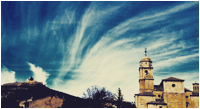
Julia Dunstan

"Depart: Porto / Arrive: Santiago" the ticket read. There was a cathedral to see in the capital of Spain's northwest Galicia region and there was time in our schedule to visit this so-called "holy place", a place in Spain like Rome or Jerusalem, a place where relics and a Biblical apostle rest, where pilgrims gather over centuries. Santiago had a history of ritual and return. Its Cathedral, Catedral Santiago de Compostela, within medieval walls, hand-carved and hugged by plazas, was stirring in 2009 with a contemporary resurgence of the pilgrimage - El Camino de Santiago de Compostela.
We entered the cathedral directly through the southern facade from the intimate Plaza das Praterias with its ornate statue of horses leaping out of the water. (I had eagerly leapt out of the bus at the sight of the great, dark spires reaching to the sky). The liturgy of the Pilgrims' Mass was underway and I was calmed by its musical interludes and ceremony, then astounded by the performance of the medieval ritual of the Botafumeiro, the swinging of the giant incense burner. The practice originated to cleanse the road-worn, disease-ridden pilgrims who entered the cathedral for Mass in the Middle Ages; now it was prized theatre and high spectacle for the modern congregation of a thousand.
The burgundy-robed attendants used all their weight to pull and lift and heave and swing on ropes, the burning vessel, which flew to vaulted ceilings. I followed it, wide-eyed, until the enormous stone edifice of religion was smoke filled, aromatic.
But it was not this magnificent ritual of the Botafumeiro that was responsible for my resolve that day to walk (at a time in the future), the French Way of Saint James. My Camino Frances, began with the connection I felt to the familiar faces of the bedraggled but elated pilgrims who stood with me there. I assumed they had walked across Spain holding everything, onto the old stone streets of Santiago and then to the Plaza Obradoiro to face its great Baroque Cathedral: masterpiece, granite hard, moss soft. They had whispered to themselves in their moment of arrival: I am pilgrim I am here... I am home
And that's how it unfolded my Camino resolve; I would step out of my routine, step away from home, leave behind all that I had, say goodbye to all whom I loved and relied upon, give myself the gift of a pilgrimage of the heart, a time to move through the landscape bravely on my own in order to go deeply into the sanctuary of my being, to a place of love and peace, one day, one month, and I did.
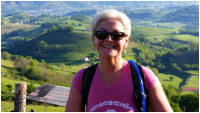
April/May 2017, St Jean Pied de Port to Santiago de Compostela and beyond to Finisterre. My Camino: more than eight hundred kilometres of Spanish landscape, Spanish skies and a pilgrimage, under my own steam, of my own volition, just me (and the thousands of pilgrims from around the world).
I arrived at the foot of the pass on the French side of the Pyrenees in St Jean Pied de Port to late April snow, eight years later. Flights from Sydney and trains from Paris had delivered me there, resolute, alone, prepared, excited and with nervous trepidation. My plan was to walk into Santiago in thirty days time having dissolved into the space it took me. (I'd thought about time and space and wondered if there was a different way to perceive them). There was buzzy excitement and movement in the Basque village with its historic walled town and central square, Place du-Gaulle. St Jean Pied de Port had become a modern gateway to the Camino, the world's pilgrims seeing it as a starting point. There are historic landmarks and monuments to see, the high castle, cafes, restaurants, as well as shops packed with hiking gear and scallop shells along steep, cobbled streets. The water from the Pyrenees runs right through the centre and sweeps along the walls of the Notra Dame du Bout du Pont, the Church of Our Lady at the End of the Bridge.
This bridge was beautiful under the mist and my feet the morning I departed for Roncesvalles with my equipment, my itinerary and my resolve, which missed a beat or two as it skipped back to 2009 then jumped on ahead to eight hundred kilometres.
Day One
I walked hard to an altitude of 1,450metres with my poles and daypack, sunglasses, warm coat and hat, through stunningly beautiful high-mountain grazing land of horses with bells and views falling away. I passed Orisson and Fontera to Col de Lepoeder at the highest point and felt good about the preparation for my laps around the sun. The distance of twenty-six kilometres (adjusted to thirty-two with the incline) was strenuous but achievable, and the rocky pathway down into Roncesvalles for my first overnight stay, was a stroll.
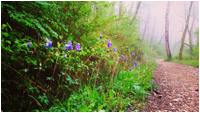 My accommodation was booked for the journey and my bag was transported each day to the next point on the itinerary, tucked away and daunting. The plan was to walk to Pamplona in three days, via Roncesvalles, Zubiri and Akerreta, then to ride a mountain bike to Astorgo (having crossed the Maesetta in nine), before resuming the walk all the way into Santiago. An average daily distance on foot would be twenty-five kilometres and an average on the bike would be fifty. I had thirty days including rests and all weather scenarios to finish as well as an emergency contact number in Spain if assistance was needed. These were the forgettable logistics of my solo Camino; unforgettable were the surprises and the experiences I had on the way.
My accommodation was booked for the journey and my bag was transported each day to the next point on the itinerary, tucked away and daunting. The plan was to walk to Pamplona in three days, via Roncesvalles, Zubiri and Akerreta, then to ride a mountain bike to Astorgo (having crossed the Maesetta in nine), before resuming the walk all the way into Santiago. An average daily distance on foot would be twenty-five kilometres and an average on the bike would be fifty. I had thirty days including rests and all weather scenarios to finish as well as an emergency contact number in Spain if assistance was needed. These were the forgettable logistics of my solo Camino; unforgettable were the surprises and the experiences I had on the way.
I did not anticipate meeting so early in my journey (or at all), three little kittens just before Akerreta on their way to find a replacement milk jug for their mother, but the ground yawned and I had fallen back through gravelly tunnels to my childhood where the colours of my storybooks met me and the personified characters spoke my language.
This story had been a favourite of mine and steady, rhythmic walking had brought it back, a tale from the past. So impressed was I as a child by the kittens' resolve to make amends for their naughty play that had resulted in the breaking of their mother's precious milk jug. Intrepid they were, like me, and they devised a journey across hills and fields a long way from home to find one just like it to honour her and keep her happy. And they did; the journey and the jug.
I was fascinated as a child by that elaborate floral jug on the page, smooth white handle, pouring lip, my hand pressed to its shape. It had been lost and found. I had not expected to think about it again or to have it lead my thoughts in the way it did. We were home without our parents, four sisters growing up. Pillows were never to be thrown in the lounge room and romping was for outside.
Sit quietly please, have manners. Don't crash the coffee table and break your mother's milk-glass vase and stick it up with clear nail polish for four years to hide your misbehaviour, Miss.
We did ... we did ... we did all that, and we were innocent until she saw the cracks and held us to account. And what about her thick-paper heavy bound school books with pencil-in-hand drawn diagrams: Biology, History, Geography? Éand the dresses and blouses she sewed for us? Where did her brown hair years go and where is she now, my strong, industrious mother?
And then a magical encounter with a tiny, shiny-nosed creature that could have stepped from the pages of Cinderella. I did not expect a small brown field mouse, foraging on the side of my path and glimpsed by chance, to allow me to pat it, to gently stroke its back ... a mouse! I was holding my breath as I leant down towards it. I noticed that its filament fur was not just brown, but every shade of grey and gold in the light that morning, and I left it while it stayed, still foraging.
Would you stay to play a little longer with me in this light, innocent child, soft reminiscence?
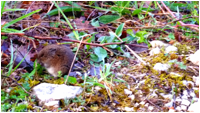
Roncesvalles or valley of thorns with its medieval atmosphere and turbulent Charlemagne past has a resident population of thirty. Within the Province of Navarra, this quiet hillside settlement with purple flowers leading to it, misty with its monastery and Romanesque chapel as I first saw it, welcomed me and lead me softly on towards Pamplona, a vibrant, expanding, now university city founded before Christ by the Roman General Pompaelo.
I was glad to have missed her traditional Running of the Bulls through the streets that I had walked - Pamplona's annual Festival of San Fermin in July - and glad to be back out on the natural paths in the forested woodlands that lead away having sampled my first city, her souvenir shops, bright lights and piano accordions.
Day Four
Onward on bike to Puente la Reina from Pamplona, the climb is steep along a rocky path edged with lines of wind turbines to Alto del Perdon at 750metres where the striking Peregrino Monument stands, and a line of turbines continues.
I was looking at myself when I looked at these thickly rusted iron cut-out sculptures, human forms, pilgrims, horses, flags on poles, pressing onward, into the wind, into the world. From the summit of sculptures, the view to the west opens to the Arga Valley with her fields and forests and villages ahead of me, the pilgrim on wheels now surely turning, and waving too, to friendly Spaniards smiling Buen Camino!
Standing beneath SpainŐs turbines they whirr like a galaxy, enormous, white and cylindrical. Hundreds and hundreds of columns across the land. I saw them pink one day; a whole line of turbines along the horizon, standing pink against a rosy dawn sky, stretches of mauve and honey-green before them. I was in the odd, forgotten town of Castrojeriz where it seemed everyone had left with the ruin of the castle except the bar tender and one cigar-smoking patron with his dogs. I looked across the terracotta roof tiles that morning from my window to a candle-pink row of turbines and marvelled at modern technology, at sustainable production of energy and the ancient place where I stood.
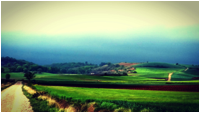
Red poppies led the way to Estella then Logrono and to a public drinking fountain where the water is wine. In Spain the red wine flows like a distant sound of a pearl accordion, swayed and played for coins in the plaza, but more than music, more than sangria, it's the land that opens the heart. The folding hills and the long ribbon road floats upward and carries you away. I could see it always ahead and feel it flutter behind, the ribbon road ... the ribbon road ... there it is and there we are, the little pilgrims and the clouds.
And the Maesetta ... oh the wide Maesetta ... breeze, sky and space. Keep riding, ride on, keep going, go onward, go further, far into the land, one turning land, far into the sky, one moving sky. Four hundred kilometres across flat earth on a bike, over, inside, onward. Its friend the sky, broader, deeper, bluer, turning blacker than itself. Soft mother earth impression and our father-light sky of the Maesetta. Spain's Palencia region is vast and the scheduled daily distances stretched out to meet it. Time dissolved during the days spent here. There was only space as I peddled onward, one day to a friendŐs prayer and its granting with the desert wind at my back. The whirring of my mountain bike prayer wheels sang when they heard it.
Thank you, the wind at our back ... thank you, the wind at our back ... thank you ...
Day Ten
Carrion to Calzadilla rolled by on the plains of Spain where crops grow to feed a nation and the long fleeced sheep graze. I sat on the ground beside the bike to film a flock of dusty sheep, so close as to feel drawn in by their dustier, quiet-herding shepherd. The earth is clay red and gravelly here and I crossed the provincial line into Leon with days of gravel and skies to go. Between the cities of Burgos and Leon the Maesetta clouds moved.
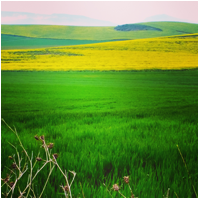
When I arrived at the Cathedral of Saint Mary of Burgos, it took my breath away when I had no breath to take. I had ridden seventy-six kilometres against a strong headwind from Santo Domingo and I was spent, in awe of an arrival itself. The vast Gothic structure before me was white silk, not rock, standing against a blue sky screaming of a devotion that I knew little about. Lacework limestone, intricate treasure-filled cloisters, and my hotel room stared at it from twenty metres. It fell with a purple rain dawn as I left it the next day with my roses and a bracelet of jade, and I captured from my bike an eternal image.
Leon surprised me too. I took a wrong turn from Calzadilla, (the shepherd had heard me) which turned out to be right and there was nothing left to be said. The Santa Maria de Leon Cathedral, Gothic and frescoed, stood proudly against a dull grey sky for my arrival, brightened by umbrellas and packed warmth inside crowded cafes.
Leon Cathedral is a velvet jewel box on a crystal plate in space. Ornate, elaborate with Renaissance and Baroque elements, more than a hundred stained glass windows, incredible from within. A House of Light built over Roman baths, tall frames of colour and stories, side by side, denying the weight of stone for six centuries and the press of gravity for all time, and each tall impossible mirror telling and retelling the fragile, old narrative.
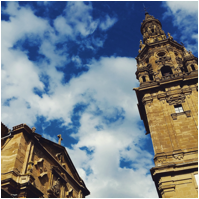
Day Twelve
Back on foot for Santiago and my poles became my companions; together we'd follow the red-calved pilgrims caught by yesterday's sunburn. They were ultra light and imperative as they tapped a metronomic rhythm and saved me from a tumble or two to remember. I named them, eventually, Then and Now, but Now could just as well be Then and Then could just as well be Now as we went from now to then. Interchangeable they were in their transitory way. Then could become Then-n-Now and Now could just as easily be changed to Now-n-Then. These were the funny little games I played close to my hands as I followed, through time, the bright yellow arrows that circled the sun. My twin poles, alike they were and friendly, and once or twice accidentally left behind, only to have a shop keeper running out, poles in hands up high calling out:
Son estos tus polos? Son estos tus polos?
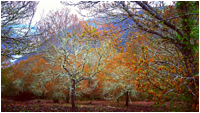
I loved the forests that I walked through, always deeply breathing their air and fragrance and stillness and age. From the silver birch and the elm and the old oaks of the eastern Navarra region to the green pines and the eucalypts of Galicia. But the chestnut forests of Villafranca were gorgeous in light rain, golden bright and lichen covered, supreme above the clouds and the navy blue mountains of the distance. I looked around me from a thousand metres high, remembering the baked-stone day that had been yesterday and celebrating my decision to climb to Alto Pradela from Villafranca that day.
Early start, dawn soft, light rain, heavy mist, steep climb, poles scraping, wild gardens; no one to see me but a wild deer ... and I saw everything from the clouds and the mountains, the valley to the distant township, the golden chestnut forests deep in their carpet of old winter leaves ... and the winding road.
As beautiful as the streams that flow and the arched bridges and cathedrals that stand are the forests that grow and let their leaves fall to the ground that we walk on. The forests and the streams are reflections and they will hold us in their arms, and we in ours, will hold the bridges and cathedrals, wide open in surprise at their beauty.
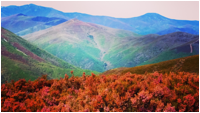
I was an artist as I walked the shady pathways, the tranquil valleys and the high Camino mountain ranges. Me, a nouveau painter, scenically and spatially inspired, with a new plan for a series called Camino Canvas once and for all. I was swimming in wild nature and the urge to paint it out and over, to touch it again, to feel and colour its mood, was strong.
When I get home I'll sift and sort and I'll know the photographs that are the ones, powerful and perfect for the painting. I will.
Scene after scene of golden grasses, charcoal storms, lime green land before them, wild lavender mountains, boronia-tea tree gardens, red poppy paddocks and dancing skies.
Strappy leather belts of grape vines cut low to the earth, to the gnarly, turning stumps season to season in the La Rioja and El Bierzo regions. Row after row after row of brown belts in dry, red soil sweeping down hillsides and fanning out to my step as I moved.

Day Twenty
And on ... quench a nation, quench a world with Spanish wines. The stocky vines held promise in their pushing buds. Promise for the bottle and smiles in the summer-vintage hearts of us all.
I loved the vineyard land that extended to cherry tree orchards. I really did!
Sip a wine, pick a cherry, sip a wine, pick a cherry, keep walking, walking, walking ... the sky is always there ...
And so I did walk into the sky, miraculously. And the hobbit-like, thatched-roof pallozas of the settlement at thirteen hundred metres was The Grail of O'Cebreiro. It opens its low wooden doors and round structures to the pilgrims who walk the mountain ranges of O Courel and Os Ancares and it feels like a ski slope of adrenaline and wood smoke. What a garden ascent to an alpine place! A paradise of wildflowers, whole mountainsides of lavender and mint and purple flowing thyme, native yellow mustard flowers, blue grasses and pink orchids giving way to the deep, green valleys that I had walked. My soul was soaring with the sky of blue and a wintery day warmed.
Whatever you do, wherever you go, come here one day to O'Cebreiro, Provence of Lugo, Region of Galicia, Espana.
Her Church of Santa Maria la Real, perched on the high ridge is supposedly the oldest on the entire French Way of the Camino de Santiago. It is pre-Romanesque from the eight hundreds; its sunken floors are embedded into the ground for protection against winter storms. It holds later stories often heard, about a peasant and a Eucharistic miracle and a twelfth century golden chalice.

I left O'Cebreiro with a sense of the magical, and the bronze monument of the cloaked and weathered pilgrim high at Alto San Roque, spoke to me. He pressed away from the ridge to the west, to the cold wind and looked downward to the clouds and the road, and there were warm caves of milking sheds to delight me on freezing days like these.
I gave a pebble and a shell with love from my home to an earlier monument on the road to Rabanal. The Cruz de Ferro, The Iron Cross, stood high at 1,500metres with piles and prayers and messy heaps of stones and trinkets from pilgrims' homes and hearts around the world.
Yet still, upon a rock not far from there at highest Alto Altar, to my intrigue, I found an old and broken weathered box with opened lid and tattered pages pressed inside ...
Seraphim Host was a most beautiful man. His heart was grand and gracious and his face and arms opened to the world. Seraphim lived in the mountains where the old forests grew; where the rings rang of time and time past. He loved the big sky's night Compostela, the gleaming field of stars, that lit the way for the rivers to run and guided the mariners far. But Seraphim had not always lived so far away and free; a warm and gritty, ocean-bred-boy was he ...
A wind came up, the pages blew away and the story was lost. I closed the little lid and left the box behind.
I followed the rivers and farms through Triacastela to Sarria, the donkey on a wagon and the long horned cows. Paddocks ploughed, cornered in stone, water so clear the fish were flying.
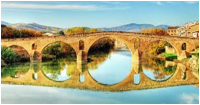
At the base of the Church of Santa Marina in old town Sarria, I admired the evocative pilgrim mural of Saint James, faded sepia, walkers on a wall of stone ... I wondered if the sad pilgrim child depicted in his company was the one who'd left, long ago, the little box... and was the story hers?
This Romanesque Church and the fortress Torre de la Fortaleza, with only its southeast, ivy-held tower remaining, rest beyond the steps in the old market square - one hundred kilometres to home.
The best way to make headway is to walk the field of stars, out in Rumi's field with the world. A primal instinct, a natural rhythm, an indigenous story of the Ages ...
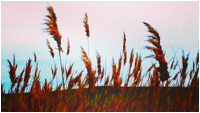
Woodland paths, gravel tracks and little hamlets led the way to Portomarin and its austere Romanesque fortress-like church high above the Mino River, wide as a lake. (Steep forests with secrets lead away). The Church of Saint John and Portomarin's host of historical structures were razed and rebuilt with the construction of the Belesear Reservoir in the1960s. Stone by stone, wall by wall, new Portomarin location, new water views for Saint John ... and there were flooding memories.
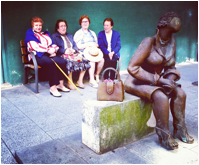
Palas de Rei, Ribadiso, Arzua to Pedrouzo - I was an Australian at home in Galicia in the ubiquitous eucalypt forests of the western region, exuding their peace and shade, peeling and shedding cream strips of bark, no kookaburras to make me laugh. Fresh new pilgrims celebrating something social with cameras and excitement had joined the road from Sarria. Lipstick and handbags, photographing arrows (a hundred kilometres only), their pilgrim passports barely stamped and too much noise for me; quiet comfort meant earlier starts.
Day Twenty-Eight
The land had levelled out to the eye and a beautiful blue dawn met me for a gentle climb around Alto de Santa Irene.
... and afterwards at Finisterre on the Coast of Death (the end of the known world before Columbus), there were purple flowers in crevices and blustery cold Atlantic winds. I had passed by Muxia and the mills of Pontemaceira, the granary at San Martino and the brown-rocked waterfall of Ezaro. I stood in peace and quietude again at the western edge of Spain on a rock of Ages and could see no distinction between sea and sky as I absorbed the cream-blue water that became air, that became light.
Day Thirty
I walked back into Santiago de Compostela on my 2017 Camino from Pedrouzo twenty kilometres away, but really from the heart of the Maesetta, dripping with heavy rain and happy tears.
I could see an eastern spire of the cathedral peeping and winking around corners of high buildings for a good kilometre as I approached the Plaza Obradoiro, the golden granite square of the cathedral's western facade. I was in narrow commercial streets of the new town, on low ground, where people worked and walked without noticing, and then new became old and I arrived ... simply, lightly, my heart breathing hard, my smile crying softly, my face and arms open like Seraphim ...
There's a niche in the central tower way above the throng of pilgrims where the sculptured Saint James sits. The winged stairs beneath it lead inside to Portico de Gloria. I went up and in and I was there now, fortuitously, for my second Botafumeiro ritual and a Pilgrims' Mass.
There was peace and gratitude in the moment of arrival and glory in the Camino of villages with chapel hearts ... and the incense burned.
*
It is profound to walk a long way on an ancient prayer path where tears are deep and smiles are true. To look behind to the blue thread mountain range and know that I had stood alone on the peaks having moved across all the silver land before it and beyond. It is profound to settle upon a deeper unity with the land and a fresh love of family and self, and I know that all that is required for the long walk is oneŐs own measure of love and strength, the measures one already has.
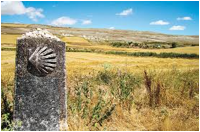
The land of the old Roman road had remembered me and had held me, the Spanish skies had danced before me, there was for me my childhood again; my toddler sisters, my young woman mother. I felt that I had threaded a necklace of Spanish towns and villages, blue Estella, yellow Logrono, mint-green Triacastela and pink Castrojeriz; a necklace of gardens and forests and stories, and that I'd added the beautiful jewels of cathedral cities, Burgos, Leon, Astorga as I walked, as I rode on my Way, and I could wear this now ... I had returned to Santiago de Compostela from the French side of the Pyrenees, on my own this time, but with the whole world and all of my life and my loved ones. I felt strong and happy as I whispered to my friend The Tree of Life, I am pilgrim ... I am here ... I am home.